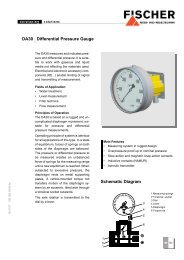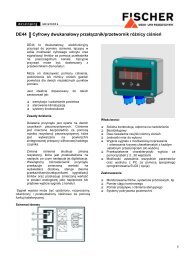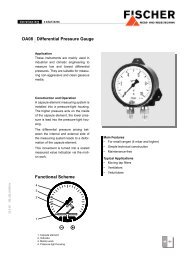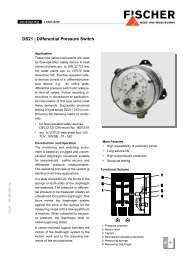NC56 Capacitive Level Sensor - Fischer
NC56 Capacitive Level Sensor - Fischer
NC56 Capacitive Level Sensor - Fischer
You also want an ePaper? Increase the reach of your titles
YUMPU automatically turns print PDFs into web optimized ePapers that Google loves.
Specifications<br />
General<br />
Sensing technique<br />
<strong>Level</strong> measuring range<br />
Operating pressure<br />
Temperature<br />
Number of electrodes<br />
Process connection<br />
Degree of protection<br />
Capacitance sensing<br />
400 - 2000 mm (other ranges available against special order)<br />
10 bar, max.<br />
Max. 80°C (ambient and media)<br />
2 (3 for diesel applications)<br />
Threaded G1¼" (M). With protective tube: G 2" (M)<br />
IP67<br />
Connection Diagram<br />
Electrical<br />
Operating voltage<br />
Supply current (without<br />
signal)<br />
Output signal<br />
Output load impedance<br />
Electrical Connection<br />
9 - 32 V DC<br />
approx. 30 mA<br />
0 - 20 mA<br />
(U B - 9 V) / 20mA<br />
9 - 32 V DC<br />
approx. 30 mA<br />
4 - 20 mA<br />
(U B - 9 V) / 20mA<br />
U B = Operating voltage<br />
12 - 32 V DC<br />
approx. 30 mA<br />
0 - 10 V DC<br />
> 5 k Ω<br />
Male M12 type round shell connector<br />
12 - 32 V DC<br />
approx. 30 mA<br />
0/1 - 5 V DC<br />
> 5 k Ω<br />
12 - 32 V DC<br />
approx. 30 mA<br />
2 - 10 V DC<br />
> 5 k Ω<br />
Materials<br />
Housing<br />
Media: contact<br />
Approval<br />
Plastic<br />
Stainless steel 1.4404, ECTFE, shrinking plastic tube (polyolefine)<br />
EC type-approval acc. to 72/245/EEC, 95/54/EC<br />
Type-approval No. e13*72/245*95/54*2182*00<br />
Installation<br />
The <strong>NC56</strong> <strong>Capacitive</strong> <strong>Level</strong> <strong>Sensor</strong> is installed vertically downward at the top of the<br />
vessel in which liquid level is to be measured. It is fitted into a G1¼-F threaded socket,<br />
located as close as possible to the center of the tank. The lower ends of the rods must<br />
be at least 10 mm above the tank bottom to avoid contact with any sludge that may be<br />
present. The electrode rods can be cut at site to a shorter length, if required, but must<br />
be of equal length.<br />
Commissioning and <strong>Level</strong> Setting<br />
The <strong>NC56</strong> <strong>Capacitive</strong> <strong>Level</strong> <strong>Sensor</strong> can be put into operation after it is installed.<br />
Detailed information regarding this is available in the Instruction Manual.<br />
<strong>Level</strong> setting is done in two steps. First, the liquid in the tank is brought to the lowest<br />
operating level. The minimum level is set simply by pressing the "Min" button on the<br />
infrared remote control unit. The LED lamp on the top of the instrument starts blinking<br />
faster, then stays steadily on, indicating that the zero level is registered. The button is<br />
then released. The tank is then filled up to its highest operating level. The "Max" button<br />
on the infrared remote control unit is pressed as before, until the instrument's LED is<br />
continuously lit. The <strong>NC56</strong> registers the maximum level and the level setting procedure<br />
is complete. The minimum or maximum limit level settings can be altered at any time,<br />
whenever the need arises, using the same procedure. If only one of limit setting needs<br />
to be changed, only one of two level setting buttons is used, after the liquid level in the<br />
tank is adjusted accordingly.<br />
For a downward characteristic (empty tank = high signal and filled tank = low<br />
signal) register the value for MAX with empty tank and the value for MIN with<br />
filled tank.<br />
Accessories<br />
Infrared remote control unit model EU04.<br />
1. Infrared remote control<br />
2. Button “Min“<br />
3. Button “Max“<br />
4. LED lamp<br />
5. Infrared receiver








